#robinson crusoe jr
Text
!!!NEW REVIEW!!!
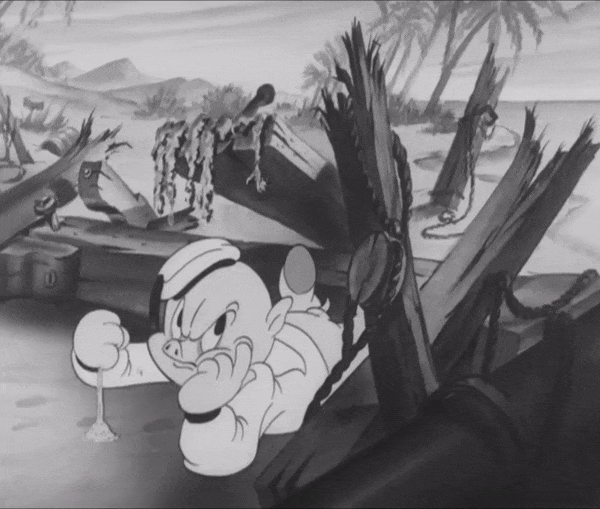
for the first time since early 1938 (that isn’t a returnee, as is the case with Friz Freleng) Warner’s invites a new director to the stand: Norm McCabe. in spite of such a short career—drafted into the military in late 1942 and the studio reaching capacity upon his 1946 return–he proved to have one of the longest careers out of any of the directors (and being the last to pass away in 2006), even working for Steven Spielberg’s Amblin Entertainment in the ‘90s on such shows as Tiny Toons and Animaniacs to name a few.
having gotten his feet wet co-directing with a Bob Clampett out on sick leave, Robinson Crusoe, Jr. is the first short to truly put his skills to the test: a burlesque of the ever popular Daniel Defoe novel (whose lack of lampooning now is pretty apparent) with Porky as the titular castaway.
#anything involving Robinson Crusoe is ripe with racist stereotypes and this is no exception! tread with caution#lt#looney tunes#robinson crusoe jr#mccabe#reviews#..when is the last time i posted about a Norm McCabe short?? gotta be at least 2 years oof#that changes now!#okay not counting the two reviews prior: Jan 2022 and the post before that Jan 2021 WHOOOOS#*WHOOPS but that too
25 notes
·
View notes
Text
The Jewish hidden language — now made audible for mass audiences — drew Jewish listeners in as a differentiated part of the mainstream American audience for popular culture. The Jewish language remained partially hidden to those members of the audience that could not recognize Jolson's kol nidre or Cantor's freygish improvisation; but for Jews its appearance within the broader context of mainstream culture signaled another set of possibilities for Jewish identification if you knew where and how to listen.
However, the ability to hear these performances did not necessarily rely on pure Yiddish roots, either. Samuel Raphaelson, the author of the short story on which the play and eventually the film were based, famously traced his inspiration for the play to a Jolson performance of Robinson Crusoe Jr. in which Jolson played three roles, including Friday. American songwriter Harold Arlen told a similar story about playing a Louis Armstrong recording for his father, a cantor. He recalled:
I brought home a record of Louis Armstrong. I don't remember now which it was. My father spoke in Yiddish. And you have to remember, he was brought into this country originally to Louisville, Kentucky, so he must have picked up some of the Blacks' inflection down there. Anyway, I played him this record, and there was a musical riff in there — we used to call it a "hot lick" — that Louis did. And my father looked at me, and he was stunned. And he asked in Yiddish, "Where did he get it?"
These men heard Jewish strains in African-American jazz, which meant they listened in a different way than jazz's original audience, and likely in ways different from their non-Jewish peers and counterparts. Whether or not the Jewish strains were "really there," and whether there are some intrinsic musical similarities between the minor scales of the blues and the modes of Jewish sacred music is a debate that will likely never be resolved, regardless of the attentions and attempts of musicologists and fans. What these stories and others like them do reveal are the ways that turning our attention to the ways in which people listen — as opposed to the ways in which they sing or speak — opens up alternative modes of identification, enjoyment, and articulation.
—Ari Y. Kelman, "The Acoustic Culture of Yiddish," 2006
30 notes
·
View notes
Text

1916 Ad for Al Jolson appearing in "The N.Y. Winter Garden's Greatest Musical Triumph" "Robinson Crusoe, Jr.". at the Lyric Theater, Philadelphia, Pennsylvania. From Kenneth McIntyre, FB.
17 notes
·
View notes
Text
"The Henpecked Duck": A Morbidly Intensive Reflection (Part 1)
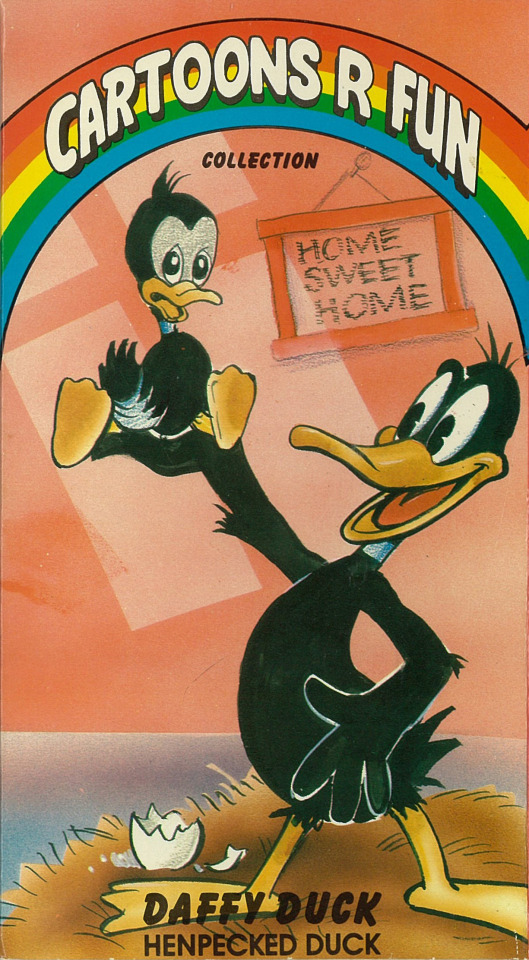
(image: vcrfromheck.tumblr.com)
What you see before you is a facsimile of a VHS tape my grandmother mysteriously owned in the early nineties. The tape was specifically for my older sister and myself in the hopes that it would pacify us if we got too rowdy. My grandmother eventually donated it once we were older....without asking my permission. We're not on speaking terms at the present moment.
The videotape was entitled "Cartoons R Fun", which is embossed on a rainbow you might see arched over Mount Ararat post-Deluge. Indeed, cartoons "r" fun, if you forgive the juvenile usage of a homophonic letter as a plural present tense of the verb "to be".
Daffy Duck, proudly standing on a tan blob with thin pencil lines to signify a nest (one that's peacefully floating on a violet overcast sky), is holding a freshly-hatched, over-sized duckling in his hand, as a quaint HOME SWEET HOME knick-knack looks on lovingly. Not an accurate depiction of the advertised short, but we'll cross that poorly-drawn bridge when we get to it. However, the tilted Dr. Caligari-esque shadow of a window in the background is indicative of the mood of the short in question.
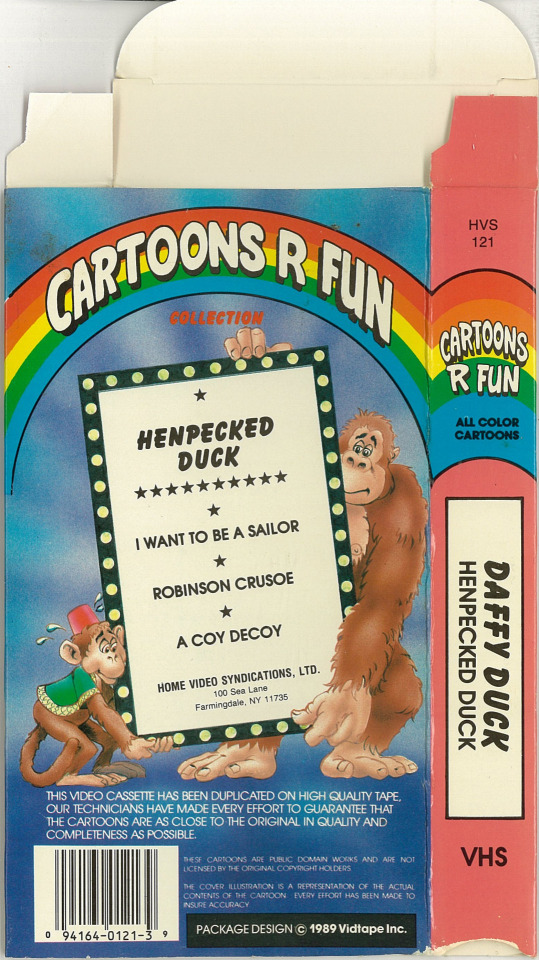
(image: vcrfromheck.tumblr.com)
The tape was top-loaded with four chortle-filled public domain follies produced between 1937 and 1941. Those amusements being, The Henpecked Duck, I Wanna Be a Sailor (see?), Robinson Crusoe Jr., and A Coy Decoy, as the tape advertises in a tacky brush font, on a showbiz marquee being lugged about by two (presumably) unpaid simian laborers, "Henpecked Duck and MANY MORE..." ("Henpecked Duck", as you might have noted, is missing a definite article, adding to the lackadaisical charm of the proceedings).
These tapes were not the best quality. I know this because the last ten seconds of A Coy Decoy are cut out, missing the all-important punchline of Daffy procreating with a toy duck. (it took me fifteen years to discover this, thanks to the miracle of www.youtube). The tape was too short so it ended on a blue screen of death. The shorts were not in black-and-white, nor are they in color, as the box cover deceptively advertises with its omnipresent "all color" rainbow. Rather, it's presented in a dusty sepia-tone (the shorts fell into public domain so I can incorrectly presume that the sepia is an after-effect of neglected film preservation). This in itself is not a bad thing. I like my cartoons to look like the first act of The Wizard of Oz. They look pristine and well-preserved, like something perfectly bronzed to a fine sheen. If I were to flick my finger, the film would make an audible 'ding'.
Anyway, the cartoon that sticks out the most (obviously, it's the main feature) is The Henpecked Duck. Released on August 30th, 1941 (about three months before the United States entered World War II....this was back when the epidemic of housewives battering their husbands with frying pans was of more pressing concern than Hitler), it was directed by Bob Clampett (the insane bad boy of the Warner Bros. animation department) and written by Warren Foster. It concerns a married Daffy Duck getting into some hot water after accidentally misplacing their unborn child. It is an intense piece of marital melodrama framed through the irreverent filter of Looney Tunes.
I've always been drawn to it. Not in any sort of substantive way (I'm not a child of divorce or anything of the sort), but in the sense that it's a piece of media that I've consumed to such a inordinate degree that it gains a kind of vague meaningfulness. It's also an overlooked short that I feel should have a little light drawn towards it, as a way of saving it from the gaping maw of obscurity. And since every piece of media has been discussed to death on the internet, I thought I could annoy you and place my minuscule stakes on this 7-minute short from 1941. Hopefully, this will be the final, definitive word on the subject. My legacy depends on it.
Let's examine this short in embarrassing, navel-gazing detail, shall we?. Not just gazing, mind you, I mean gripping my hairy belly between my two mitts and, depending on how much bendable flexibility I still have stored in my rapidly fading youthful figure, blow into my umbilicus scar, until you hear an audible plop-plop-plop.
(note: I put a sepia filter on these black & white screencaps to simulate how I experienced The Henpecked Duck as a child.)
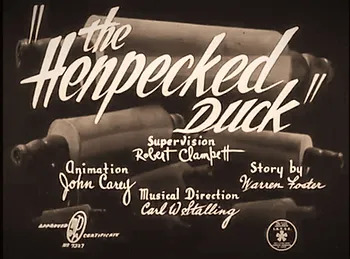
WAH WAH WAH WAH WAHHHHHHHHHH. Doodly-doo, doodly-doo, scattily woo woo woo woo doo, doodly-doo, doodly-doo, doo doo. (That was obviously Mendelssohn playing over those overlapping rolling pins.)
The short opens on darkness, a cacophony of plaintive whinging blooms on the soundtrack. People are demanding divorces left and right. The camera suddenly springs back from the darkness to reveal the shadowy entrance of what appears to be a ramshackle barn or chicken coop. It's hard to tell considering the entrance takes up the entire frame. The lack of a proper wide establishing shot and the numerous disembodied voices only adds to the feeling of anxious dislocation. A wooden plank leads forbiddingly into the darkness. A crudely written sign hangs over the entrance, "Court of Inhuman Relations."
(A small reservation I have is the sound mixing on the voices being too loud. You can almost hear Carl Stalling's score which, from the few strains that I'm able to eke out, carry an foreboding menace).
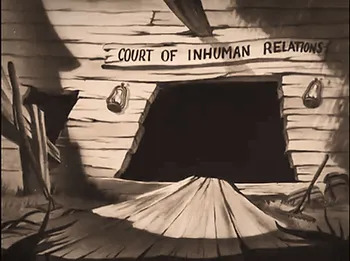
Transition to a close-up of Porky's gavel (Porky is presiding over this raucous kangaroo court) rapping on the judge's stand with an aggressiveness too intense for the viewer to even process in these first few seconds. The camera rapidly pulls back from the gavel, to a wider shot of Porky, to an extreme low-angle long shot of the aisle as the crowd quiets down. Already, we have two instances of the camera springing back rapidly from close-ups to establishing shots, as if the cameraman was suddenly dropped out of the sky and is quickly trying to adjust to the foreign scenario he has just encountered. Needless to say, it has a startling effect.

Porky Pig announces the first case of the day: Duck vs. Duck. He orders Mr. Daffy Duck to approach the stand. There is a shot from Porky's perspective where we can see the entire courtroom with Porky's gavel and water jug hugely prominent in the foreground (they take up almost half of the frame, symbolizing the firm grip that the rural judicial system has even over the lowliest waterfowl). The courtroom is a surreal scene indeed. It consists of barnyard animals, from a duck with an abnormally long neck, to a dopey-looking black mutt, to a fat hog sitting uncomfortably on one of the benches, and a snoring elderly hen (who provide a few visual gags near the end of the short).
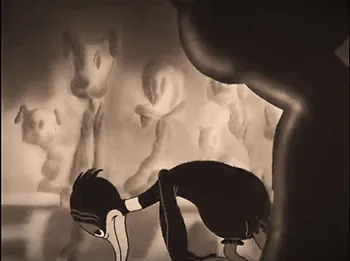
Daffy Duck slowly shuffles up the aisle. His overbearingly grim disposition are not unlike a POW during the Bataan Death March, with his slouched posture and hangdog eyes. Stalling's score is just as slow and methodical; a prominent trombone emitting a onomatopoeic 'wah-wah'. He walks past the onlooking crowd, eerily still and blurred in the background. The few figures he walks past in the foreground are featureless and emit a dull glow like bronze statues. The stillness of the crowd make Daffy's isolation unbearable.
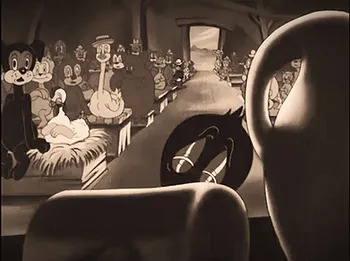
Daffy approaches the stand as Porky calls up Mrs. Daffy Duck. Before I move on, I must point out a glancing detail and a naggingly under discussed trope of old 30's-40's cartoons: glassy eyelids. Daffy blinks a few times as he looks up at Porky on the stand. His eyelids have a glassy, polished tint, as if run through a shoe buffer. It is an unsettling detail, adding to the surreality of the mise-en-scène.
Mrs. Duck, unlike Daffy, charges up the aisle with a straw boater cocked at an angle, in the manner of old-time gangsters, and a ridiculous poofy ball bouncing from it (what else could one call it but a 'poofy ball'?), giving off a unexpectedly violent energy. Unlike the pathetic trombone used on Daffy, Stalling utilizes blaring trumpets, giving her entrance a martial air. I must amusingly point out that Mrs. Duck is essentially Daffy with a hat and skirt (no pronounced Minnie Mouse eyelashes either).

Shot from an intense low angle close-up, Mrs. Duck, the perennial battle-ax stereotype, chants the four most iconic words of my salad years: "I WANT A DIVORCE! I WANT A DIVORCE!" It's amazing how a single moment can be so easily etched into such an impressionable young mind. The immediacy of it (no one in real life can shout banal declarations with such dramatic relish) and its startling bluntness struck me as unusual in a Looney Tunes short. It's so dramatically heightened when compared to the more relatively light-hearted tone of other Warner Bros shorts. Though as I've grown older, I can't help but see a bit of the parodic in it; melodrama bursting to the brink of burlesque. Not to mention the almost shrill string section that accompany these outbursts.

Mrs. Duck rains a flurry of invective on Daffy (with a couple of thwacks on the head from her vanity parasol). We get a closeup of Daffy, where we get some fine acting on his end. As she twaddles on, he winces and grimaces, being verbally battered into submission. At one point, she commands him to respond. In a subtle bit of comic acting, Daffy opens his beak in an air of sarcasm (noted by the over-exaggerated intake of breath), and just as he's about to speak, he automatically snaps his beak closed just as she tells him to shut up. Henpecked, indeed, if you are unironically tickled by the avian-adjacent pun of its title.
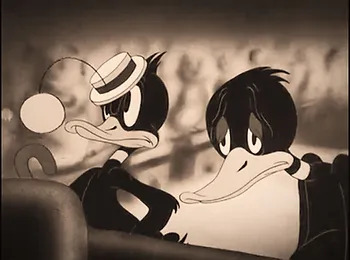
The Honorable Porky Pig orders Mrs. Duck to calm herself and explain the origins of this particular domestic strife. I must point out that as Porky speaks, we get a two-shot of Mr. and Mrs. Duck. It's almost a still shot, except for the poofy ball on her hat, which slowly bounces until it comes to a stop, like a toy soldier winding down. It's a minute detail that adds to her energetic characterization. Even when she's still, she's moving.
At this point we are launched into the dramatic thrust of the short. We are spirited backward into the past by way of flashback. This is where the real fun begins.
We arrive at the abode of the Ducks (we get no exterior establishing shot) where silhouettes (projected on a wall of two by fours, adding to the rural decrepitude) of the couple hover over a nest with a plump half-oval of an egg nestled on top. A framed embroidered artwork of the words "Home Sweet Home" adds a touch of ironic bonhomie (the music of "Home Sweet Home" is gently playing in the background). Mrs. Duck is lovingly instructing Daffy to manually incubate the egg while she goes to visit her mother. She walks past the camera and out of frame. She then violently (and comically) juts her face back into frame (her beak thrusting like a dagger) with an idle threat of strangulation (the music suddenly turns menacing).

Daffy sits obediently on the nest, replying to every matrimonial trumpet blast with the soft-spoken yet seethingly sarcastic, "Yes, m'love." Daffy's comic acting is brilliant here. The frozen smile, the disingenuously coy eye-blinking, the listless, non-committal head nodding. Not to mention Carl Stalling's expressive soundtrack, with Mrs. Duck's dialogue highlighted by stormy percussion and Daffy's highlighted by softer staccato variations on the "Home Sweet Home" theme. When Mrs. Duck leaves, Daffy gets up off the nest and vents out his frustration, mocking her with multiple "Yes, m'love's" (we also get a sense of the wide space of their sparsely furnished house, giving it the feeling of a stage). The omniscient Mrs. Duck suddenly bursts through the door screaming, "What's that?!" Daffy springs back to the nest (the music oddly spring-like itself), a eerie moment of silence before Daffy quietly, obediently says, "Yes, m'love." Mrs. Duck leaves.

After an indeterminate passage of time, Daffy is still sitting on the egg (his arms uselessly crossed as opposed to the demure limpness he expressed when the missus was about), looking bored and restless. Carl Stalling's score here is particularly striking, giving this little interlude a weird note of foreboding. Daffy decides to examine the egg, shake it, and balance it precariously on his digit. How I relate to Daffy's fascination! There is something miraculous about that ovoid vessel. Its perfect shape and dimensions. Its firm yet fragile shell, its smell reminiscent of sticking your hand out of a speeding car window, then smelling the palm once retracted. When you put a knife to a boiled egg, you see its uniform circularity with its white outer layer and its yellow yolk (sans zygote, of course).
Daffy, in a fit of pure sponteneum, lays to rest the age-old chicken-or-the-egg conundrum by rendering it moot. We get an extreme close-up of his hand fondling the egg then pressing the egg between his palms until it is squeezed out of existence. Even Harry Handcuffs couldn't pull off a feat of such trickery. Daffy, standing confidently on his nest like a master sleight-of-hand, chants some magical hoodoo ("Hocus pocus, flippety flam, razzmatazz, and alacazam!") and the egg reappears between his two fingers (with an amusing "boing", clearly a human's voice).
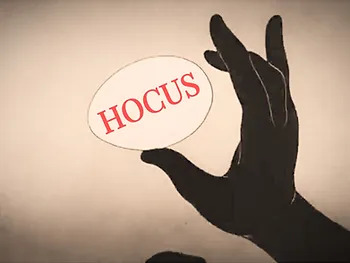
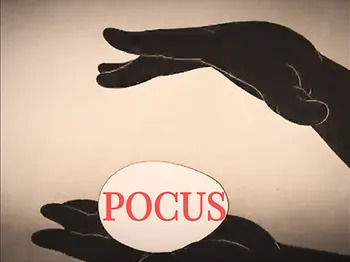

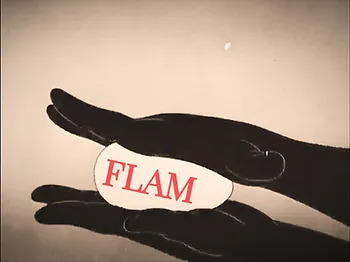



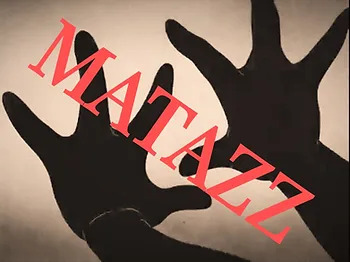
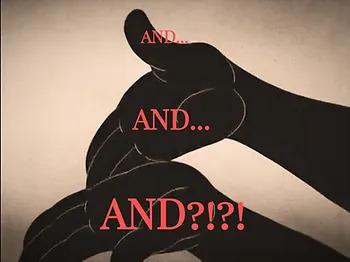

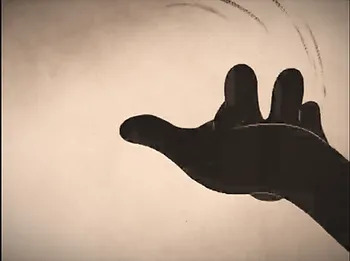
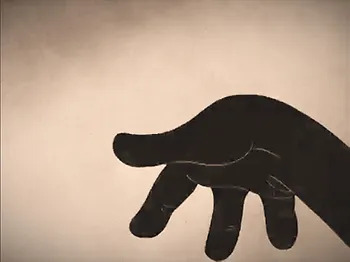
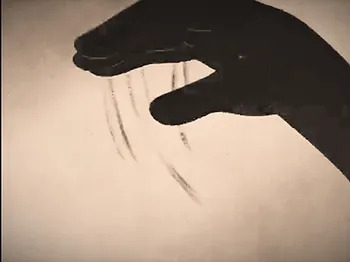
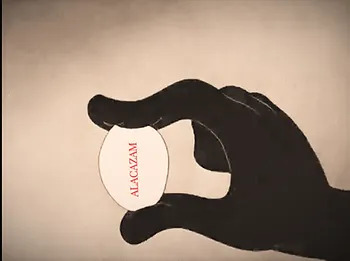

He is amazed by his newfound abilities and addresses the audience with cross-eyed relish. Notice that the borders of the frame move inward so there there is a thick black outline underneath and to the sides. We cut to a wide shot of Daffy stepping off his nest (making a hearty reference to Major Bowes, an old "Gong Show"-esque radio program) and then stepping forward and out of the frame, his feet planted on the black. It's meant to be a fourth-wall gag but it's awkwardly executed because you notice the frame retracting in preparation for the gag. Frankly, I'm not quite sure why they had to break the fourth wall at that particular moment.

Daffy makes the egg disappear again. I must point out Stalling's lovely rendition of Juventino Rosas' waltz, "Sobre las Olas" (Over the Waves), a calming Wurlitzer standard, but like its title, suggests that Daffy is heading into choppy waters. He repeats the magic words and, lo and behold, the egg does not reappear. Daffy's eyes bulge out of his head and looks at the audience, shrugging with uneasy reassurance. He tries again. Same result. The tempo of the scene steadily grows faster (along with the score) as Daffy desperately tries to make the egg reappear. Daffy is now hysterically banging the floor, imploring an indifferent deity to make his unborn child whole again. Of course, it wouldn't be Looney Tunes if they didn't make Daffy break the fourth wall ("Say, is there a magician in the house?"), then immediately falling back into character (now that felt like a more appropriate fourth-wall gag than the previous one). A clock ticks on unrepentantly.
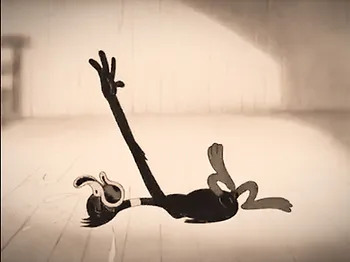
(continued in Part 2...I hoped to fool you and claim it's Part 1 as a dramatic cliffhanger for this intense marital thriller...it's only because Tumblr allows 30 images per post so I had to break it up into two parts....I apologize if I have completely demystified this [allegedly] mature and thoughtful examination)
5 notes
·
View notes
Text

Squideo’s Favourites: WALL·E 🌱
Released in 2008 as Pixar Animation Studio’s ninth feature film, its third since the company was purchased by the Walt Disney Company in 2006, WALL·E had been in the works since the nineties. Created by Andrew Stanton and Pete Docter, this fast classic has become one of Pixar’s standout films. So much so that Disney pushed for an Academy Award Best Picture nomination.
Controversially, this wasn’t accepted by the judges but WALL·E did go on to win their Best Animated Feature prize, and also scooped it up at the BAFTAs, Golden Globes, Hugo Awards, People’s Choice Awards, Saturn Awards, and many more. It even scored two Grammys for Randy Newman and Peter Gabriel’s music performances.
We’re diving into the production behind this animated film, exploring the style and techniques which came together to create this compelling story.
Creating a Story
When Andrew Stanton first came up with the idea for WALL·E, the premise was simple: “what if mankind left Earth and somebody forgot to turn the last robot off?” This was first pitched in 1994 when the young company was thinking about its future films, yet WALL·E wouldn’t start production until 2003 – eventually making it onto screens in 2008.
Stanton continued to develop the idea of a Robinson Crusoe robot with Pete Docter in the nineties, even as both went on to direct other Pixar projects – Finding Nemo (2003) and Monsters, Inc (2001) respectively. There was doubt, however, that this film could be pulled off. Pixar had created anthropomorphised robots before in its first animated short Luxo Jr. (1986). The lamp depicted in this short would become Pixar’s mascot, but was a feature film about a robot something that could be compellingly animated?

What helped to move WALL·E into production was the release of the massively successful Finding Nemo. Like robots, fish weren’t expressive. Like outer space, water was difficult to animate. And yet they pulled it off, releasing what became the highest-grossing animated feature film of all time up to that point and Pixar’s first Academy Award winner. Directed by Stanton, he now had the attention of the company who were eager to hear his next idea.
“WALL-E was a very conscious dive into risk. I knew nobody really wanted to make it. But I also knew nobody could say no to me because Nemo was just so big… we’d been so successful at that point that we could afford the hiccup. If we called it wrong economically or critically, we’d survive it.” Andrew Stanton
The film centred on two robots who only spoke when communicating their names and directives. The majority of WALL·E’s first half is largely free of dialogue, with the exception of live-action recordings from Hello, Dolly! (1969) and Buy n Large’s owner. Many robot characters only converse with chirps and beeps, and the only robot with full lines of dialogue is 2001: A Space Odyssey-inspired villain Auto.
youtube
Key to getting WALL·E into production was the approval of Steve Jobs, who was Pixar’s primary investor and acted as their co-founder and chairman. Jobs split his time at Pixar with Apple where, in 2004, an exciting new product was announced to a select number of people: the development of the first iPhone. The developments at Apple ended up having a profound impact on WALL·E, with the team at Pixar receiving prototype phones before the general public. The film was punctuated throughout with Apple references, using the sound of the Mac boot-up chime when WALL·E finishes charging, and the iPod and iPhone inspiring EVE’s design.
The story is built on themes of environmentalism and global catastrophe, examining consumerism and complacency. One of Pixar and Disney’s most politically themed films, WALL·E attracted conservative criticism but that didn’t stop it from performing at the box office: grossing $532 million worldwide. Receiving widespread acclaim, WALL·E became the second Pixar feature film to be preserved by the National Film Registry and Library of Congress in 2021. In 2022, WALL·E also became Pixar’s first film selected by The Criterion Collection.
Animation Style
While other Pixar films typically generated between 50 and 75,000 storyboards for each production, WALL·E ended up with over 125,000 drawings and 96,000 storyboards. A lot of thought had to go into the character’s design, since their emotions would have to be conveyed physically rather than verbally.
“Robots are a huge challenge, because robots are function-based machines. When you’re drawing them, you can only make up so much stuff that doesn’t actually function, or the person looking at them, even if they’re not engineers themselves, they’re going to notice that that joint wouldn’t actually work. So it became important to look at actual robots. You can only make so much up out of your head.” Jason Dreamer
The team looked at a variety of robots, including those made for bomb disposal. For Jim Reardon, head of story for WALL•E, it was important that they didn’t “draw human-looking robots with arms, legs, heads and eyes, and have them talk. We wanted to take objects that you normally wouldn’t associate with having humanlike characteristics and see what we could get out of them through design and animation.”
To help, Stanton arranged film screenings of classic silent films from the likes of Charlie Chaplin and Buster Keaton to show how silent film actors told stories without reliance on dialogue.
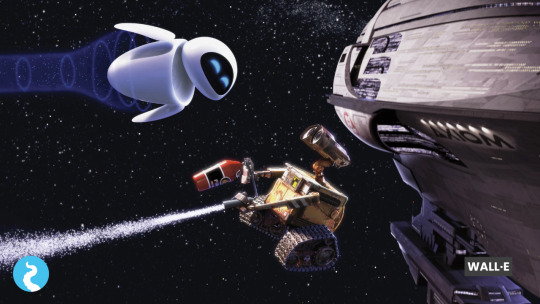
To create the wasteland that WALL·E is left behind in, the animators looked at everything from local dumps to the abandoned city of Chernobyl. For the modern ship Axiom, they looked to Disneyland’s Tomorrowland and cruise ships. To design the human characters, they consulted with physiologist James Hicks to find out the effects of atrophy and prolonged weightlessness while living in space, proving that no detail was too small for the team behind WALL·E.
All of these considerations created a future that seems tangible, and helps to drive the importance of the film’s themes. WALL·E ends on an optimistic note, with Jim Capobianco’s end credits which show the evolution of humanity through different schools of art. For audiences facing the realities of climate change and environmental destruction, this confidence in the power of humanity to fix our world is the right ending. Perhaps explaining why it is one of the few Pixar films to receive no sequel or animated shorts. The story is perfect as it is.
youtube
Get Started With Your Video
Inspired to create a unique animated video of your own? Watch the video below to get a better understanding of how Squideo can help promote your business, then get in touch with us to find out more!
youtube
#wall e#pixar animation studios#disney pixar#pixar#andrew stanton#pete docter#randy newman#peter gabriel#luxo jr#finding nemo#steve jobs#apple#iphone#ipod#criterion collection#jim reardon#jason dreamer#jim capobianco#Youtube
2 notes
·
View notes
Text
Happy 112th Birthday Norm McCabe


Another one of the least known cartoon directors at Warner Bros’ Termite Terrace.
Starting at WB, he was hired as an in-between during the Harman and Ising days in 1932. McCabe even went with both Bob Clampett and Chuck Jones to assist Ub Iwerks to complete two of Iwerks WB shorts, which was Porky and Gabby and Porky’s Super Service.
McCabe later became an animator for Frank Tashlin, then Bob Clampett, animating some of the most famous shorts of all-time, such as Clampett’s beloved, overtly surreal Porky in Wackyland.

He would later take over Clampett’s old unit.
His first directors credit: The Timid Toreador (1940) co-director Bob Clampett
His solo directional debut: Robinson Crusoe, Jr. (1941)
In a similar manner of Robert McKimson and Arthur Davis, McCabe gets the short end of the rope. He directed nothing but black-and-white Looney Tunes shorts, never the later color Looney Tunes or Merrie Melodies. Much like Clampett and Tex Avery, McCabe would have a habit for the use dated topical humor relating to the world of the early 1940s like WWII, and his notoriously politically incorrect shorts, such as “Tokio Jokio” (his final short) and even the best ones like “The Ducktators” and “The Daffy Duckaroo”, was probably what set him back in his status.
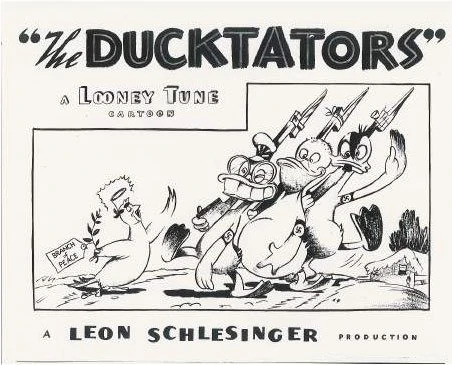

youtube
youtube
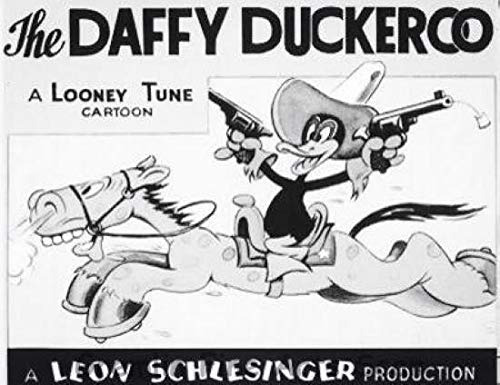
Regardless, McCabe still did some great shorts. His directional style, I would say, was a mix between Freleng and Tashlin, razor-sharp timing, topical satire and insane wacky gags. He had quite easily THE shortest-lived directing job at WB, with only Tashlin and Arthur Davis out beating McCabe who directed only 12 short films.
The reason for McCabe’s short-lived directional career at WB was due to being drafted. When he returned, he would try to get his job back as a director, but Eddie Selzer wasn’t so easy on let him back in.
McCabe was the longest-living WB cartoon directors up until his death in 2006. He worked in commercial illustration for Bozo the Clown such as children’s book and educational films. He later continued his animation career, animated on Disney’s Bambi, revisited WB once again in the 1960s, went to Filmation, then DePatie-Freleng Enterprise, was an animator on Ralph Baskih’s Fritz the Cat, and did his second revisiting to WB again in the 1980s and 90s, as an animator on The Night of the Living, The Duxorist among other things, was a sheet timer and timing director on Tom Rugger’s Tiny Toon Adventures, Animaniacs, Freakazoid! and Taz-Mania, and The Sylvester & Tweety Mysteries, and even was an animator on the infamous 1993 Pink Panther TV series at MGM, a director on Bobby’s World for Fox Kids, a sequence director on 1987 Teenage Mutant Ninja Turtles show. Surprisingly, McCabe admitted to hating his work at Termite Terrace once he met up with animator Mark Kausler, screening his shorts. According to Kausler himself, McCabe was “incredibly modest about his Looney Tunes, he hated them all!”, once had a screening in North Hollywood, pleading to everyone “oh turn those off, I can’t stand looking at them”. Well, whatever the case was, your cartoons were the best Norm!
#Norm McCabe#looney tunes#merrie melodies#warner bros.#birthday#wb directors#the ducktators#the daffy duckaroo#world war 2#wwii#1940s#short films#film directors#animators#animation director#animation#tom rugger
10 notes
·
View notes
Text
Termite Terrace Club - October 25th
1930 - Box Car Blues - Dir. Hugh Harman and Rudolf Ising
1941 - Robinson Crusoe Jr. - Dir. Norman McCabe / Rookie Revue - Dir. Friz Freleng
1947 - Dog Gone Cats - Dir. Arthur Davis
TV
1993 - Animaniacs Season 1: “You Risk Your Life” / “I Got Yer Can” / “Jockey for Position”
2003 - Duck Dodgers Season 1: “Quarterback Quack” / “To Love a Duck”
2011 - The Looney Tunes Show Season 1: “Off Duty Cop” / “Butte E. Fall”
2 notes
·
View notes
Text
Get to Know Me Tag Game
I was tagged by @just-inside-her, who is a new friend, so I'm excited about that! (And I know it's been a LONG time since you tagged me, but I tend to forget I've saved something in my drafts..."
Rules: Tag nine people you want to get to know better
Three ships: Pepperony, Caskett, Tiva
First ship: Sam/Jack from Stargate SG-1

Fave color: Purple! But I'm a very colorful person, so I like all of them.
Last song: Me and Liza cover by John Partridge
Last movie in the theater: Pretty sure it was Avengers: Endgame
Last show: Last show I actually finished was.... probably Secrets of the Zoo.
Currently watching: Stargate SG-1, Stargate Atlantis, Secrets of the Zoo: Tampa
Currently reading: Dark Lover by JR Ward, Bridge to Terabithia by Katherine Paterson, Robinson Crusoe by Daniel Defoe, and Lost Roses by Martha Hall Kelly

Currently working on: I've got 2 fairly sizeable cross stitch projects in progress (2 Harry Potter ones and one with colorful lilacs), and I'm participating in quite a few fandom events (several of which are bingos), and I'm moderating two of those.
Current obsession: I don't think I've had a real good obsession for a little bit. *Glances around, waiting for the next one to hit*
Tagging: Anyone who would like to play too! Even if we've never interacted before, please play if you want to!
0 notes
Text

6 notes
·
View notes
Text
this blogs tbr
as mentioned in the description, i will be reading and reviewing the entire literary canon, plus some others i think should be there, and others i just want to read. i will be marking each read book with a line through it as it has been read
the list is as follows.
To Kill a Mockingbird - Harper Lee
The Great Gatsby - F. Scott Fitzgerald
Pride and Prejudice - Jane Austen
Jane Eyre - Charlotte Brontë
1984 - George Orwell
Wuthering Heights - Emily Brontë
The Catcher in the Rye - J.D Salinger
Romeo and Juliet - William Shakespeare
Animal Farm - George Orwell
Frankenstein - Mary Shelley
Lord of the Flies - William Golding
The Picture of Dorian Gray - Oscar Wilde
Of Mice and Men - John Steinback
Hamlet - William Shakespeare
The Scarlet Letter - Nathaniel Hawthorne
Sense and Sensibility - Jane Austen
Great Expectations - Charles Dickens
A Tale of Two Cities - Charles Dickens
Brave New World - Aldous Huxley
The Metamorphosis - Franz Kafka
The Canterbury Tales - Geoffery Chaucer
Emma - Jane Austen
Fahrenheit 451 - Ray Bradbury
One Hundred Years of Solitude - Gabriel García Márquez
Dracula - Bram Stoker
Macbeth - William Shakespeare
The Adventures of Tom Sawyer - Mark Twain
The Grapes of Wrath - John Steinback
A Midsummer Night's Dream - William Shakespeare
Little Women - Louisa May Alcott
The Adventures of Huckleberry Finn - Mark Twain
Northanger Abbey - Jane Austen
Anna Karenina - Leo Tolstoy
The Old Man and the Sea - Ernest Hemmingway
Persuasion - Jane Austen
Slaughterhouse-Five - Kurt Vonnegut Jr
The Crucible - Authur Miller
The Bell Jar - Sylvia Plath
A Christman Carol - Charles Dickens
The Odessey - Homer
The Hobbit - J.R.R Tolken
To The Lighthouse - Virginia Woolf
Lolita - Vladimir Nabokov
Crime and Punishment - Fyodor Dostoevsky
Dr. Jekyll and Mr. Hyde - Robert Louis Stevenson
Robinson Crusoe - Daniel Defoe
Othello - William Shakespeare
Beowulf - Unknown
Heart of Darkness - Joseph Conrad
Their Eyes Were Watching God - Zora Neale Hurston
The War of the World - H.G. Wells
A Clockwork Orange - Anthony Burgess
The Aeneid - Virgil
The Adventures of Sherlock Holmes - Authur Conan Dayle
Twenty Thousand Leagues Under The Sea - Jules Verne
Metamorphoses - Ovid
The Illiad - Homer
Moby-Dick - Herman Melville
The Jungle Books - Rudyard Kipling
The Count of Monte Cristo - Alexandre Dumas
Mansfield Park - Jane Austen
Les Miserables - Victor Hugo
Hard Times - Charles Dickens
Sense and Sensibility - Jane Austen
Gulliver's Travels - Jonathan Swift
Oliver Twist - Charles Dickens
The Sonnets and a Lover's Complaint - William Shakespeare
The Divine Comedy - Dante
Alice's Adventures in Wonderland - Lewis Carroll
Alice Through the Looking Glass - Lewis Carroll
The Jabberwocky and Other Nonsense - Lewis Carroll
A Handmaids Tale - Margret Atwood
The Poems of John Keats
The Secret Garden - Frances Hodgson Burnett
This Perfect Day - Ira Levin
One Flew Over to Cuckoo's Nest - Ken Kessey
The Art of War - Sun Tzu
The Time Machine - H.G. Wells
Orlando - Virginia Woolf
The Little Prince - Antoine De Saint-Exupéry
Pygmalion - George Bernard Shaw
annnnddd thats the list for now ! feel free to recommend books that you think id like !
#literature#fiction#writers#writers on tumblr#reading#bookworm#booklover#bookshelf#book#currently reading#book reviews#book recommendations#booktok#book blogger
8 notes
·
View notes
Note
Might I please jump in with the suggestion that, while making Superman a Pulp Hero can be a little tricky, making LEX LUTHOR a Pulp Hero would be peculiarly easy? (In fact making him a Pulp Hero without making major alterations to his fundamental character might be far more difficult - given how much of a self centred jerk the man is).
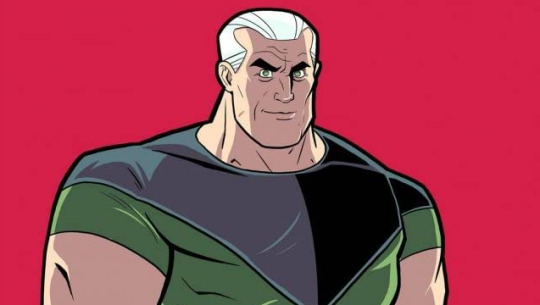
Funny you mention that because, while I haven't read the comic enough to really speak much of it, that kinda seems to be the basic premise of Chris Roberson's Edison Rex, a comic about a supervillain who has to step in as Earth's protector after defeating his superhero enemy, with the titular character being a Lex Luthor-analogue who looks like Doc Savage with Thomas Edison's haircut.
In fact, the idea of Thomas Edison as a protagonist is not even a unique one, not when one of the earliest examples of dime novel sci-fi was named after him. Just as popular in it's heyday and irredeemably reprehensible as the man itself even. If you want to imagine how Lex Luthor looks like as a pulp hero, all you need is to look at the genre called "Edisonade", starting in the 1870s, and you'll see why you wouldn't even need to make that many substantial changes to Luthor's fundamental character if you were to try to pass him off as a dime novel sci-fi protagonist. Not just because pulp supervillains already starred in stories and magazines as is, but because Edisonade as a genre is already built to accomodate characters like him.
The term "edisonade" or "Edisonade" – which is derived from Thomas Alva Edison in the same way that "Robinsonade" is derived from the hero of Daniel Defoe's Robinson Crusoe – can be understood to describe any story dating from the late nineteenth century onward and featuring a young US male inventor hero who ingeniously extricates himself from tight spots and who, by so doing, saves himself from defeat and corruption, and his friends and nation from foreign oppressors.
The Invention by which he typically accomplishes this feat is not, however, simply a Weapon, though it will almost certainly prove to be invincible against the foe, and may also make the hero's fortune; it is also a means of Transportation – for the edisonade is not only about saving the country (or planet) through personal spunk and native wit, it is also about lighting out for the Territory.
Afterwards, once the hero has penetrated that virgin strand, he will find yet a further use for his invention: it will serve as a certificate of ownership, for the new Territory will probably be "empty" except for "natives". Magically, the barefoot boy with cheek of tan will discover that he has been made CEO of a compliant world; for a a revelatory set of maxims can be discerned fuelling the entrepreneurial engine of the edisonade: the conviction that to fix is to patent: that to exploit is to own - Sci-Fi Encyclopedia's entry on Edisonade
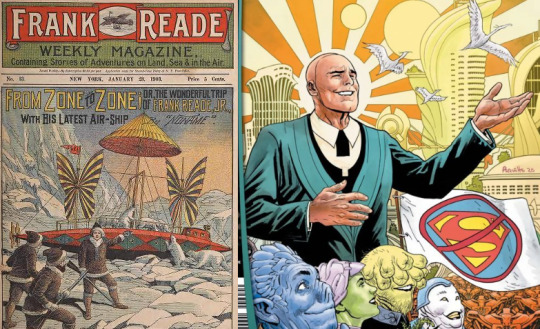
The Edisonade, coined by critic John Clute after the Robinsonade, can be defined simply enough: it is a story in which a young American male invents a form of transportation and uses it to travel to uncivilized parts of America or the world, enriches himself, and punishes the enemies of the United States, whether domestic (Native Americans) or foreign.
The Edisonades were almost entirely an American creation and appeared in dime novels as serials and as complete novels. They were the single largest category of dime novel science fiction and were the direct ancestors not only of 20th century boys’ fiction characters like Tom Swift but also one of the fathers of early 20th century science fiction, especially in the pulps. And the Edisonades were among the most morally reprehensible works of fiction of the 19th century, on a par with the dime novels the Confederacy published to glorify slavery - Jess Nevins's article on Tom Edison Jr
Fun for the whole family!
Granted (and thankfully), Edisonades as a specific genre died down in popularity following the end of dime novel, although you can very easily see how their influence lingered on much of sci-fi as we know it. It makes for a rather interesting coincidence even that, in the turn of the century, as the dime novels and the Edisonades died down in popularity and the pulp magazines proper started to take their place in American culture, the Mad Scientist began to arise in popularity as a stock villain to the point you can make a drinking game out of reading pulp novels where the kind professor with a weird invention turns out to be a cut-throat master villain.
The Mad Scientist as an archetype, which is what Luthor started as, actually seems pretty much non-existant prior to the 1890s (the term seems to have only caught on somewhere after 1893 following the World's Fair Columbian Exposition) and only really started taking shape in the 1900/1910s following the influence of German Expressionism villains and characters like Fu Manchu (far from the first yellow peril mad scientist, but definitely the most popular) and the myriad of pulp villain, even pulp villain magazines, named after some form of "Doctor" (Doctor Death, Doctor Satan, Doctor X, etc)
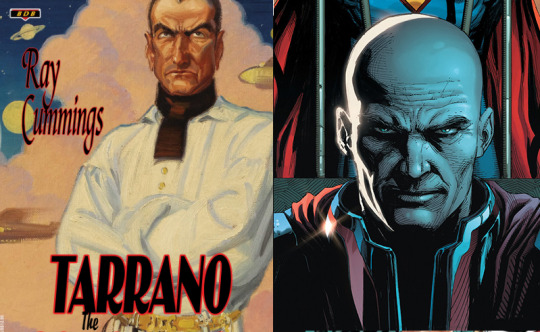
I'm not particularly fond of Arch-Capitalist Luthor and I'm not gonna be the billionth guy online to talk about the relevance of that take on Luthor, because my preferred take on Luthor is more on the Emperor Scientist / Ubermensch Arch-Asshole, the kind that's not so much a stock villain archetype because he doesn't have to be, because "Lex Luthor" has practically become it's own archetype, you know it when you see it. I would prefer to emphasize a Luthor who's got more in common with pulp sci-fi supervillains who starred in their own stories, but the stories themselves had no delusions about what the characters were. And I think Luthor can make one hell of a protagonist in this regard.
In another place, under different circumstances, this man might have been a Caesar, a Napoleon, a Hitler, or an Archimedes, a Michelangelo, a da Vinci. A Gautama, a Hammurabi, Gandhi. But in this place, at this time, he was more. Superman made him more.
As an artist saw objects as an amalgam of shapes, as a writer looked upon life as a series of incidents from which plots and characters could be constructed, Lex Luthor's mind divided the Universe into a finite number of mathematical units.
The time he had spent in jail so far this year was three months of thirty days each, three weeks, six days, two hours, and sixteen minutes. This included four weeks, one day, and three hours in solitary confinement during which time he could do nothing more useful than count seconds and scrupulously retain his sanity.
There were other super-criminal geniuses in the world; he had met some of them, dealt with them on occasion. They were chairmen of great corporations, grand masters of martial arts disciplines, heads of departments in executive branches of governments, princes, presidents, prelates, and a saint or two. Unlike Luthor, these men and women chose to retain their respectability. They had trouble coping with honesty.
Luthor was not motivated by a desire for money, or power, or beautiful women, or even freedom. In solitary Luthor decided that his motivation was beyond even the love or hate or whatever it was he had for humanity. It was consuming desire for godhood, fired by the unreasonable conviction that such a thing was somehow possible.
He began by being an honest man. He was a criminal and said so. - The Last Son of Krypton, Chapter 12
#replies tag#dc comics#lex luthor#superman#elliot s maggin#last son of krypton#tarrano the conqueror#pulp supervillains
34 notes
·
View notes
Text
porky’s voice gradually turns into daffy’s and of course i’m way too enamored with it than what i need to be
#norm mccabe’s daffy anyway#daffy is very chewy with his words. they’re not very open ended. his a sounds are very bitey and have that ‘aey’ sound#like porky saying ‘waey’ here#in more of his ‘street talking’ colloquial voice i guess daffy will abbreviate words so he can ramble on more#something is pronounced as ‘sum’n’ and feels more closed and less airy than the fully enunciated ‘something’#he drops his g’s which again closes things off#very bitey and chewy#of course his vocal inflection is going to depend on the director and the year#this matches most with norm mccabe’s daffy because THIS is norm mccabe and around the same timeframe of cartoons (1941-1942ish)#like a bob mckimson daffy sounds different than a chuck jones daffy#or even in the same director: a 1939 bob clampett daffy is vastly different from a 1943 clampett daffy#i analyze the dialogue of these characters (daffy and porky esp) SOOO MUCH i’ve hogged comments on how i write them well/understand them#and that’s why because i’m such a sucker for dialogue and absorb it like a sponge LOL the variety in sentence structure and syntax and#emphasis on words is fascinating to me#i’ve started incorporating daffy-isms into my everyday vocabulary involuntarily LOLLLL he’s ghe most interesting to me by far#okay kudos if you read this far god bless#lt#robinson crusoe jr#mccabe#vid
35 notes
·
View notes
Text
THE DARK CORNER
November 10, 1947

Synopsis ~ A former San Francisco private eye, just in back New York after two years in prison (the victim of a frame-up), finds himself a target for another send-up and murder.
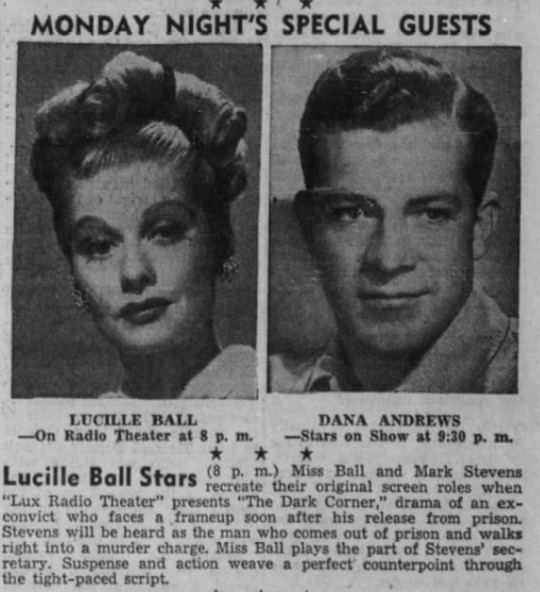
Directed by Fred MacKaye with musical direction by Louis Silvers and sound effects by Charlie Forsyth
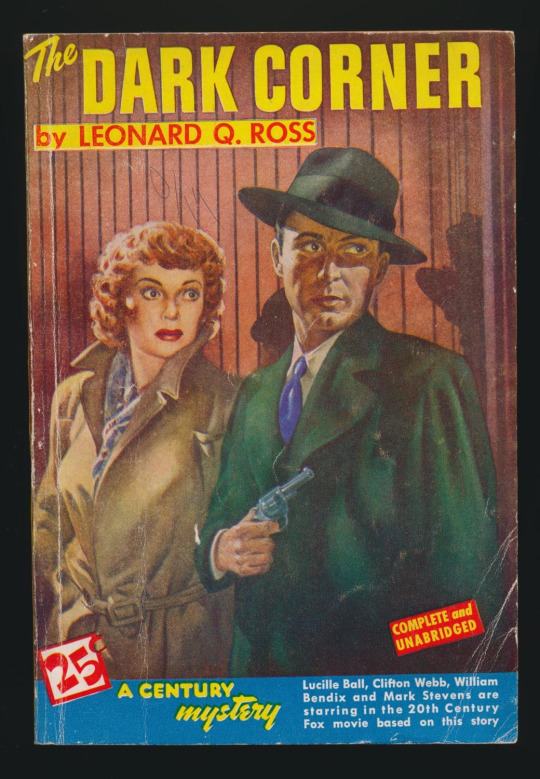
Adapted for radio by Sanford Barnett from the screenplay by Jay Dratler and Bernard Schoenfeld based on the book by Leo Rosten.

It was based on the 20th Century Fox motion picture of the same name released on May 8, 1946.
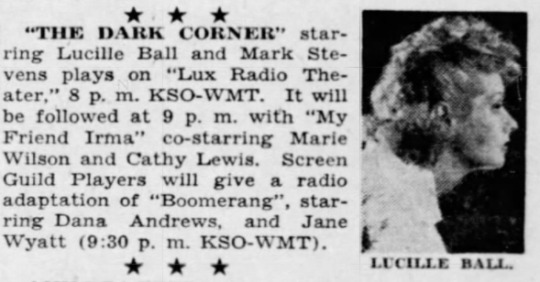
In later years, Lucille Ball was vocal about hating the experience of shooting The Dark Corner. Director Henry Hathaway's bullying reduced Ball to stuttering on set, at which point Hathaway accused her of being inebriated. At the time, Lucille Ball was suing to get out of her contract with MGM. As a result, MGM loaned her to Fox for this picture, which included a significant pay cut.

Lux Radio Theatre (1935-55) was a radio anthology series that adapted Broadway plays during its first two seasons before it began adapting films (”Lux Presents Hollywood”). These hour-long radio programs were performed live before studio audiences in Los Angeles. The series became the most popular dramatic anthology series on radio, broadcast for more than 20 years and continued on television as the Lux Video Theatre through most of the 1950s. The primary sponsor of the show was Unilever through its Lux Soap brand.
CAST

Lucille Ball (Kathleen Stewart) was born on August 6, 1911 in Jamestown, New York. She began her screen career in 1933 and was known in Hollywood as ‘Queen of the B’s’ due to her many appearances in ‘B’ movies. “My Favorite Husband” eventually led to the creation of “I Love Lucy,” a television situation comedy in which she co-starred with her real-life husband, Latin bandleader Desi Arnaz. The program was phenomenally successful, allowing the couple to purchase what was once RKO Studios, re-naming it Desilu. When the show ended in 1960 (in an hour-long format known as “The Lucy-Desi Comedy Hour”) so did Lucy and Desi’s marriage. In 1962, hoping to keep Desilu financially solvent, Lucy returned to the sitcom format with “The Lucy Show,” which lasted six seasons. She followed that with a similar sitcom “Here’s Lucy” co-starring with her real-life children, Lucie and Desi Jr., as well as Gale Gordon, who had joined the cast of “The Lucy Show” during season two. Before her death in 1989, Lucy made one more attempt at a sitcom with “Life With Lucy,” also with Gordon.
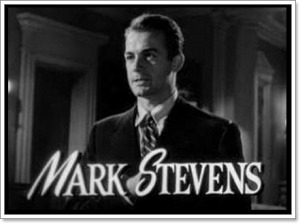
Mark Stevens (Bradford Galt) reprises his role from the film version of The Dark Corner (1946). He became a contract player for Warners at $100 a week in 1943 but they darkened and straightened his curly ginger-colored hair and covered his freckles. At first he was billed as Stephen Richards, he later changed it to Mark Stevens at the suggestion of Darryl F. Zanuck when he switched to 20th Century-Fox. He died in 1994 at age 77.

Joseph Kearns (Ralph Wickett) appeared on “I Love Lucy” as the psychiatrist in “The Kleptomaniac” (ILL S1;E27) and later played the theatre manager in “Lucy’s Night in Town” (S6;E22). His most famous role was as Mr. Wilson on TV’s “Dennis the Menace” (1959). When he passed away during the show’s final season, Lucy regular Gale Gordon took over for him, playing his brother.
In the film, the character was named Hardy Cathcart and was played by Clifton Webb.
Norma Jean Nilsson (Little Girl at the Boarding House) was a child actress who left Hollywood at age 19 after appearing in 16 films and television shows.
In the film, the character carries a slide whistle, which is not used here. She was played by Colleen Alpaugh.
Wally Maher (Fred Foss aka Stauffer) was born on August 4, 1908 in Cincinnati, Ohio. He was known for Mystery Street (1950), The Reformer and the Redhead (1950) and Hollywood Hotel (1937). He was married to Molly Bruno. He died on December 27, 1951.
In the feature film, the role was played by William Bendix, who would go on to fame as the title character in TV’s “The Life of Riley.”
Dan O'Herlihy (Anthony Jardine) was an Irish-born actor nominated for an Oscar in 1954 for Robinson Crusoe. In 1960 he made an appearance on Desilu’s “The Untouchables.” He was in two of the RoboCop movies. He died in 2005 at age 85.
In the feature film, the role was played by German-born actor Kurt Krueger.
Fay Baker (Mari Wickett) was born on January 31, 1917 in New York City as Fanita Baker Schwager. She was known for Notorious (1946), The House on Telegraph Hill (1951) and Deadline - U.S.A. (1952). She died on December 8, 1987.
In the feature film, the role was taken by Cathy Downs, making her first credited screen appearance.
ENSEMBLE
Trude Marson was seen in uncredited roles in four films from 1937 to 1947.
Noreen Gammill started her screen career as the voice of Catty the Elephant in Disney’s Dumbo (1941). She made two background appearances on “The Andy Griffith Show” (1963 and 1964), filmed on the Desilu backlot.
William Johnstone is probably best remembered as Judge Lowell on the long-running daytime drama “As The World Turns”. Prior to that he worked extensively in radio and took over the role of Lamont Cranston on "The Shadow" playing opposite Agnes Moorehead when Orson Welles left the series.
Janet Scott was a regular background voice on “Lux Radio Theatre” with dozens of episodes to her credit from 1937 to 1955.
Lois Corbett was married to Don Wilson of “The Jack Benny Program” and as such did more than a dozen episodes of the television shows with him from 1954 to 1964.
Edward Marr was seen in The Affairs of Annabel with Lucille Ball in 1938. He was also in two Bob Hope TV specials with Hope and Ball in 1966 and 1970.
Stanley Farrar was seen on “I Love Lucy” in “Home Movies” (ILL S3;E20) and “Staten Island Ferry” (ILL S5;E12). He on “The Lucy Show” in “Lucy and Arthur Godfrey” (TLS S3;E23) and “Lucy Meets Danny Kaye” (TLS S3;E15).
Herb Butterfield was born on October 28, 1895 in Providence, Rhode Island. He was known for The Halls of Ivy (1954), The House on Telegraph Hill (1951) and Shield for Murder (1954). On radio, he portrayed the Commissioner on NBC 's "Dangerous Assignment" (1949-53) and Clarence Wellman on "The Halls of Ivy" (1950-52). He died on May 2, 1957
Cliff Clark was seen with Lucille Ball in Her Husband’s Affairs (1947), Miss Grant Takes Richmond (1949), and The Fuller Brush Girl (1950).
OTHERS

William Keighley (Host and Producer) was the director of nearly 40 feature films between 1932 and 1953. His film The Adventures of Robin Hood (1938) was selected for the National Film Registry by the Library of Congress as being culturally significant.
Dorothy Lovett (Commercial Spokeswoman as Libby Collins, Hollywood Reporter) appeared as Meta Bauer on radio’s “The Guiding Light" (1945-47) and as Toni Sherwood in "The Adventures of Rocky Jordan". She did three films with Lucille Ball from 1939 to 1941.
Betty Ann Lynn (Herself, Act Two Intermission Guest) is best known for playing Thelma Lou on “The Andy Griffith Show” (1961 to 1965) which was filmed on the Desilu back lot.
John Milton Kennedy (Announcer) was the announcer of all 35 episodes of “The Loretta Young Show” from 1954 to 1955.
ACT ONE

William Keighley introduces the program, noting that many years earlier, director Fred Kohlmar saw a titian-haired young model who had great possibilities - Lucille Ball. He later had the privilege of presenting her in the film version of The Dark Corner. After a mention of Lux Toilet Soap, the program begins.
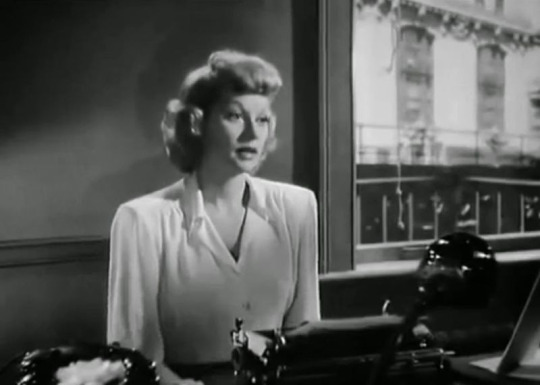
The action opens in a New York City office building on a sultry summer afternoon. Police detective Reeves visits the Offices of Bradford Galt, Private Investigator and speaks to his secretary, Kathleen Stewart.
Galt enters and Reeves wonders why Galt didn’t notify him that he moved offices after his prior unpleasantness. Galt asks Kathleen to have dinner with him. After dinner, Galt asks her to go dancing but she’s wise to his advance. As they walk down the street, they realize that they are being followed.
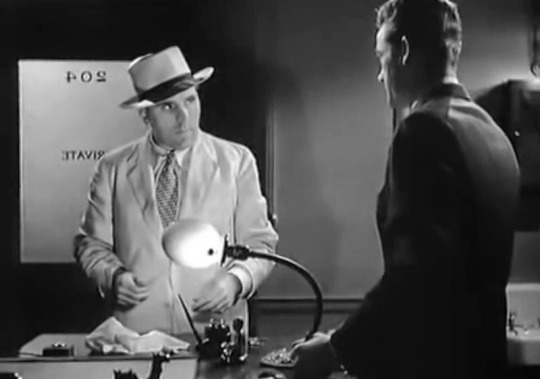
Kathleen takes a cab back to the office, while Galt confronts the pursuer at gunpoint, taking him back to his office for questioning. He says his name is Fred Foss, and that he’s also a private detective. Galt doesn’t believe him and decides to beat the truth out of him.

After some roughing up, Fred discloses that he is being paid to tail Galt by Anthony Jardine. In the tussle, some ink spills on Foss’s white suit. He lets Foss leave. Kathleen was supposed to tail Foss after he left the office, but he tricked her and got away.
Back at his rooming house, Foss uses the hall telephone to call art gallery owner Ralph Wickett, and his ink-stained suit is noticed by a Little Girl neighbor.
At a party for his third wedding anniversary, Wickett hangs up and is greeted by Jardine, a lawyer. Mrs. Lucy Wilding takes Jardine aside pretending to ask legal advice, but it is revealed that he is blackmailing her.
Meanwhile, Galt confides in Kathleen about his past. Jardine is trying to kill Galt because he was a former partner that Galt confronted about his blackmailing female clients. Now Jardine wants to finish the job.
Mari Wickett, Ralph’s wife, is having an affair with Anthony Jardine. She wants to run away with him. At the same time, Galt is headed there to settle the score.
End of Act One

A Lux commercial break takes the form of a story from Libby Collins, Hollywood Reporter. She says she saw Universal’s The Lost Moment starring Robert Cummings and Susan Hayward. Libby says she was on location when they filmed the big fire scene, the biggest fire ever done on a sound stage. She says that she and Susan Hayward washed the soot off their faces with Lux Toilet Soap!
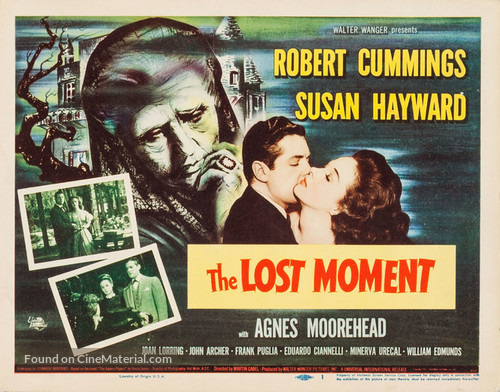
At the time of the broadcast, The Lost Moment was still two weeks from being released. It opened in cinemas on November 27, 1947. The story is set in Italy, so the cast included Edward Ciannelli, who played pizzeria owner Mr. Martinelli in “Visitor from Italy” (ILL S6;E5) and Saverio LoMedico who played the Rome hotel bellboy in “Lucy’s Italian Movie” (ILL S5;E23). The film was not a box office success.
ACT TWO

An hour has past since the end of Act One and Galt is at Jardine’s door. Galt threatens Jardine, who denies tailing him.The two fight while Mari is hiding in the other room. After Galt leaves, she convinces him to run away with her.
At the Gallery, Wickett is visited by Foss. It is clear Wickett is setting up Jardine to take the fall when he has Galt killed. Foss calls Galt to betray Jardine for a price. Galt suggests a one-on-one meeting at his apartment - 904 West 52nd, apartment 307 at 8pm sharp. Wickett will send Jardine to Galt’s apartment at 7:30pm.
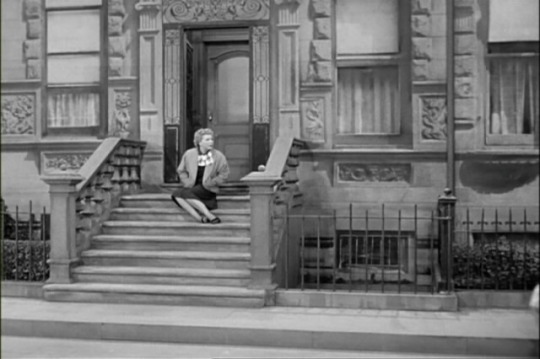
In reality, there is no such address. West 52nd Street in New York City ends at the the 600s block. This is similar to the Ricardo and Mertz apartment building. 623 East 68th Street, which, if real, would be in the East River!
Kathleen and Galt are supposed to meet at the movies, but he doesn’t show so he goes to his apartment at 8:30. Galt opens the door and reveals that Jardine is dead. Galt was ambushed with and knocked out with ether. He woke up to find Jardine’s body bludgeoned by the fireplace poker. Galt realizes he was set up.
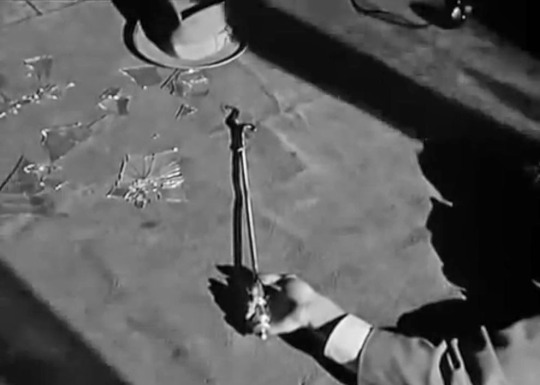
Later, Galt meets Kathleen at her apartment. He couldn’t find Foss and doesn’t know where to look next.
Wickett reminds Mari that they are due at the Kinsglsey’s that night, but she begs off. He strongly hints that he knows that Mari is stepping out on him and looking to run off.
Galt suddenly realizes that Foss would have to have his white suit cleaned, so he is determined to search all the cleaners for the suit and get his address.
Foss phones Wickett, and the Little Girl is there to overhear his conversation. Foss makes a plan to meet Wickett on the 31st floor of the Grant building.
Galt and Kathleen are about to give up on the search for the suit when a cleaner comes through. They get his address and trace Foss to the rooming house where he lives. His name turns out to be Stauffer, not Foss. The landlady reports that he moved out an hour ago and doesn’t know where he went. But the Little Girl does - and spills the beans for a quarter! Galt and Kathleen head for the Grant Building.
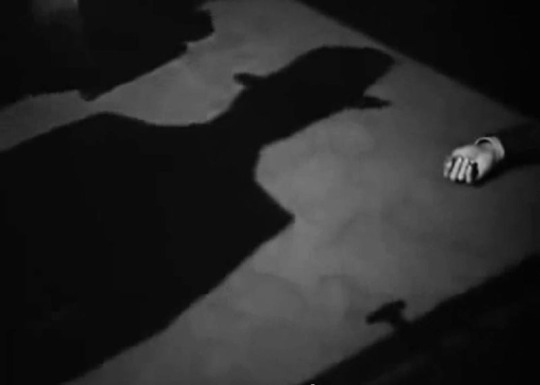
End of Act Two
In the break, Keighley interviews Fox contract player Betty Ann Lynn, who saw filming of Daryl F. Zanuck’s Gentleman’s Agreement starring Gregory Peck and Dorothy McGuire in a “very unusual picture”.

Gentleman’s Agreement premiered on November 11, one day after this broadcast, in both New York City and Chicago. It dealt with anti-Semitism and went on to win three Oscars, including Best Picture. The cast included Lucycom alumni Mike Lally, Shep Houghton, Roy Roberts, and Amzie Strickland in uncredited roles. Betty Ann Lynn says that she also likes to watch the filming of a costume picture like The Foxes of Harrow starring Rex Harrison and Maureen O’Hara, who had 26 costumes made just for her. She notes that O’Hara has a Lux complexion.

The Foxes of Harrow was released September 13, 1947. "Lux Radio Theater" broadcast a sixty minute radio adaptation of this movie on December 6, 1948, with Maureen O'Hara reprising her movie role. The movie was the screen debut of William Schallert, who did several episodes of “The Lucy Show.” O’Hara and Lucille Ball became lifelong friends after their 1940 film Dance, Girl, Dance. Like Gentleman’s Agreement, The Foxes of Harrow also features Roy Roberts, who went on to play bank president Mr. Cheever on “The Lucy Show.”
ACT THREE
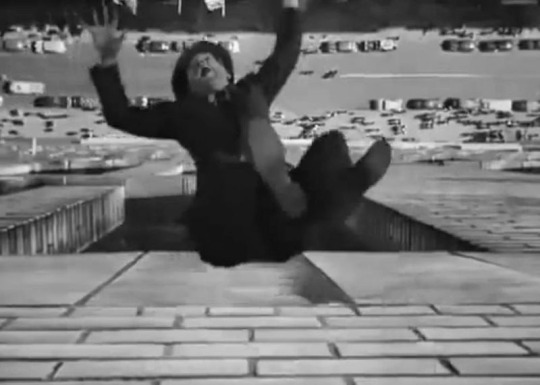
Kathleen and Galt rush to the Grant Building, where Mr. Wickett is about to settle accounts on a remote fire escape. Foss / Stauffer brings proof that Jardine is dead but Wickett throws him from the fire escape to his death.
Galt and Kathleen witness the whole incident from the street, as does the cab driver who was waiting for Foss / Stauffer. Thinking fast, Galt steals the cab which still contains Foss’s luggage. Later, we hear that the bags were only full of clothes. Kathleen urges him to keep thinking.
Kathleen suddenly remembers that the Little Girl mentioned galleries. They put the pieces together and all evidence leads them to the Wickett Galleries. Galt heads there and questions the clerk. Under the guise of buying a painting, Galt inquires about meeting Mr. Wickett, and the clerk departs. Mari comes in the side door, and Galt tells her that Anthony Jardine has been murdered. She faints. Wickett comes in and when Galt tells him the truth, Ralph locks him in the gallery vault. Mari has revived and overhears Ralph’s threats, holding a gun on him. She shoots her husband dead.

Kathleen has tipped off the police, who only want to charge him with stealing a taxi cab. Kathleen asks if he can be booked at another time because they have a date at the City Hall - to get married.
End of Story
As a curtain call, Keighley chats with Lucille Ball and Mark Stevens. He congratulates Ball on the success of her stage show, Dream Girl, a play she says she will do again in San Francisco. When Keighley asks how Lucille’s busy schedule and that of her husband Desi Arnaz’s leave any time for a personal life, Ball says that they will be playing in San Francisco at the same time.

In June 1947, Lucille Ball performed at New Jersey’s McCarter Theatre in Dream Girl, a play by Elmer Rice. It also played Brooklyn, Detroit and Boston.

The San Francisco production opened just a week after this radio telecast. As Ball states, Desi Arnaz was also in San Francisco at the time, playing in the Rose Room of the Palace Hotel, a fact that was advertised in the Dream Girl program. During the Los Angeles engagement in January 1948, Ball fell ill and had to withdraw. Although she love performing on stage, her radio career and then television success did not allow her to return to the footlights until 1960.

Lucy notes that like many other busy stars, she owes her good complexion to Lux Soap!
Turning to Mark Stevens, Lucille notes that he will play an FBI man in his next project at Fox, with Keighley as director.

Although the film’s title is not mentioned, they are referring to The Street With No Name, which won’t be released until June 1948. Stevens plays Gene Cordell aka George Manley, a covert FBI agent who infiltrates a ruthless gangster mob. "Lux Radio Theater" broadcast a 60-minute radio adaptation of the movie on January 31, 1949 with Mark Stevens reprising his film role.
Keighley notes that next week “Lux Radio Theatre” will present Jane Wyman and Ronald Reagan in Nobody Lives Forever.

The Warner Brothers picture Nobody Lives Forever was released on November 1, 1946. It originally starred John Garfield and Geraldine Fitzgerald in roles taken on radio by Reagan and Wyman, who were husband and wife at the time. Of course, Reagan left Hollywood for a grander stage, first in California as Governor, then as President of the United States. He bestowed Lucille Ball with The Kennedy Center Honor in 1986.
A public service announcement asks housewives to salvage kitchen fats and turn them in at their local butcher for cash!

These were used to make supplies for wartime, such as ammunition and weapons.
Announcer Kennedy notes that Mark Stevens appeared through the courtesy of 20th Century Fox, producers of Forever Amber.

Forever Amber is a 1944 romance novel by Kathleen Winsor set in 17th-century England. It was made into a film in 1947 starring Cornel Wilde, who appeared in “The Star Upstairs” (ILL S4;E25). When “Lucy Writes A Novel” (ILL S3;E24), Ethel jokes about finding Lucy’s hidden manuscript and burning it: “We pulled down the kitchen blind and changed the name of your novel to 'Forever Ember.'”
‘DARK’ TRIVIA

In a September 1985 episode of “Remington Steele,” a character played by Stephen Dillane has the name Bradford Galt! The stories, however, are not otherwise connected.
In both the film and the radio show, Fred Foss gives his phone number as CH-elsea 4-43510. However, according to the Manhattan phone book for 1946, there were only CH-elsea 2 and CH-elsea 3 exchanges. Real phone numbers were rarely used in film or television.

When television began to supplant radio, “The Lux Video Theatre” was introduced. It was seen from 1950 to 1959. Initially, the show was a thirty-minute weekly show featuring live stage plays, but when it moved to NBC in August 1954, the show was extended to sixty minutes. As on radio, the programs were then primarily adaptations of motion pictures. The host would introduce each act, and would conduct an interview with the stars at the end of the play. Of the cast of this radio version of The Dark Corner:
William Keighley directed an episode in 1951.
Mark Stevens did an episode in 1955.
Dan O’Herlihy did five episodes.
Joseph Kearns did three episodes.
The character name Ralph Wickett replaced Hardy Cathcart for the radio show. It is likely that they could no longer get legal clearance to use the name Hardy Cathcart, necessitating the change.
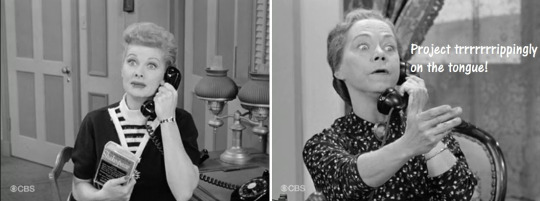
The film featured Ellen Corby as a maid, a role not in the radio drama. Corby went on to be seen as Lucy Ricardo’s high school acting teacher and in several small roles on “The Lucy Show” before her best-loved role of Grandma on “The Waltons.”

The film also features background work by Sam Harris, who did 15 films with Lucille Ball, in addition to multiple episodes of “I Love Lucy” and “The Lucy Show” as well as Harold Miller, who did eight films with Lucy and two episodes of “I Love Lucy”.

The film is available on DVD complete with DVD commentary and original trailer.

#The Dark Corner#Lucille Ball#Mark Stevens#Lux Radio Theatre#Radio#1948#Joseph Kearns#William Keighley#1947
8 notes
·
View notes
Quote
Ibn Tufayl’s message was clear — and for its times, quite bold: Religion was a path to truth, but it was not the only path. Man was blessed with divine revelation, and with reason and conscience from within. People could be wise and virtuous without religion or a different religion.
The translations of “Hayy ibn Yaqzan” in early modern Europe — by Edward Pococke Jr. into Latin in 1671, by George Keith into English in 1674, by Simon Ockley into English in 1708 — sold widely. Among the admirers of Ibn Tufayl’s work were the Enlightenment philosophers Baruch Spinoza, Gottfried Wilhelm Leibniz and John Locke, who were trying to advance a sense of human dignity in a Christendom long tormented by religious wars and sectarian persecutions.
The Muslims Who Inspired Spinoza, Locke and Defoe
A novel written by a 12th-century Arab writer about a boy alone on an island influenced the Daniel Defoe classic ‘Robinson Crusoe.’
By Mustafa Akyol
https://www.nytimes.com/2021/04/05/opinion/enlightenment-islam-robinson-crusoe.html?campaign_id=2&emc=edit_th_20210406&instance_id=28900&nl=todaysheadlines®i_id=43453557&segment_id=54952&user_id=06f6767785a14352b47f4490384ee56a
#Islam#religion#philosophy#robinson crusoe#Islamic literature#Muslim#Ibn Tufayl#Locke#Spinoza#reason#transculturation
3 notes
·
View notes
Text
A Call for Books - January 1921

On January 6, 1921, The Duncan Public Library ran an advertisement asking for book donations ahead of the Grand Opening in February. You can still access all of the 54 titles that we requested either in the library or on Project Gutenburg! Below the cut (because these are VERY long lists) you will find two lists of books with links to descriptions!
You can also read an article about it in our monthly newsletter *here*
Books from the Library, Libby, or Hoopla:
Penrod by Booth Tarkington
Pilgrim’s Progress by John Bunyan
Aesop’s Tales
Tom Sawyer by Mark Twain
Rebecca of Sunnybrook Farm by Kate Douglas Smith Wiggin
Two Years Before the Mast by Richard Henry Dana
The Prince and the Pauper by Mark Twain
Captains Courageous by Rudyard Kipling
The Amazing Interlude by Mary Roberts Rinehard
Huckleberry Finn by Mark Twain
Adventures of Sherlock Holmes by Arthur Conan Doyle
Robinson Crusoe by Daniel Defoe
Swiss Family Robinson by Johann David Wyss
Hans Brinker by by Mary Mapes Dodge
Cranford by Elizabeth Gaskell
Call of the Wild by Jack London
The Spy by James Fenimore Cooper
Little Women by Louisa May Alcott
Little Men by Louisa May Alcott
Black Beauty by Anna Sewell
The Deerslayer by James Fenimore Cooper
The Blue Fairy Book by Andrew Lang
Treasure Island by Robtert Louis Stevenson
Arabian Nights
Ben Hur by Lew Wallace
The Virginian by Owen Wister
Freckles by Gene Stratton-Porter
The Scarlet Letter by Nathaniel Hawthorne
Books from ProjectGutenburg.Org
The Bird’s Christmas Carol by Kate Douglas Smith Wiggin
The Crisis by Winston Churchill
Daddy-Long-Legs by Jean Webster
The Four Horsemen of the Apocalypse / Los Cuatro Jinetes de Apocalpsis by Vicente Blasco Ibanez
The Lady of the Decoration by Frances Little
Lamb’s Tales from Shakespeare by Charles and Mary Lamb
Little Lame Prince by Dinah Maria Mulock
Little Minister by J. M. Barrie
The Little Shepherd of Kingdom Come by John Fox Jr
Lovey Mary by Alice Caldwell Hegan Rice
Man Without a Country by Edward Everett Hale
Mother by Maksim Gorky
Mother Carey’s Chickens by Kate Douglas Smith Wiggin
Mrs. Wiggs of the Cabbage Patch by Alice Caldwell Hegan Rice
Potash and Perlmutter by Montague Glass
Ramona by Helen Hunt Jackson
Red Fairy Book by Andrew Lang
Rollo at Work by Jacob Abbot
Rollo at Play by Jacob Abbot
Standish of Standish by Jane G. Austin
Tanglewood Tales by Nathaniel Hawthorne
To Have and To Hold by Mary Johnston
Trail of the Lonesome Pine by John Fox Jr
Two Little Confederates by Thomas Nelson Page
Uncle Remus, His Songs and Sayings by Joel Chandler Harris
Water Babies by Charles Kingsley
Widow O’Callaghan’s Boys by Gulielma Zollinger
#duncan public library#100 years of Duncan Public Library#project gutenberg#book lists#reader advisory#golly this took a long time#there are a lot of good books on this list#and a lot of not so good books#but we have to acknowledge ALL of our past#and this is part of that
2 notes
·
View notes
Text
//Thank you for the tag @temarihime
1. Nicknames: Sin, Sima, Simča, Black Hole, Pickaxe (don’t know where that came from), Dictionary, Giraffe, and many more - feel free to give me a new one! I also respond to swearwords.
2. Gender: Female, but I am fine with any pronouns
3. Star sign: Capricorn
4. Height: 179cm
5. Time: 6:35pm
6. Birthday: January 15
7: Favourite Bands: I don’t care much for favouring music artists? I listen to whatever I like but uhhh...P!ATD, I guess?
8. Favourite Solo Artists: None
9. Song stuck in my head right now: Zombies - Johnny Stimson
10. Last Movie I Watched: I haven’t seen any movies in forever, I think....
11. Last show I watched: Parade’s End
12. When did I create my blog: This one was made in September 2020? Or August?
13. What do I post/reblog: Founders, shitposts, rp, Naruto-related things
14. Last thing I Googled: Anti-Americanism in Canada
15. Other blogs: My main at @twinkletits-jr
16. Do I get asks: I do
17. Why I chose my URL: Water God Tobirama, duh
18. Following: 120
19. Followers: 86
20. Average hours of sleep: 0-4h
21. Lucky number: I don’t have any but uhh... 2 3 5 7?
22. Instruments: Can’t play any but I like guitars.
23. What am I wearing: Sweatpants and an oversized sweater from the 80s my dad wore as a young adult.
24. Dream Job: Writer, concept artist, working on videogames.
25. Dream Trip: Around-the-world kind of trip?
26. Favourite food: Any dumping-type food (gyoza, mandu, momo, pierogi, etc), noodles/pasta, meats
27. Nationality: Slavic, lol
28. Favourite song right now: Dead Inside - Younger Hunger
29. Last Book I read: Robinson Crusoe (D. Defoe), Foe (J. M. Coetzee), Some Do Not (F. M. Ford) - I have to read a lot for school :’)
30. Top Three ideal fictional universes: Naruto, Harry Potter, Gravity Falls
Also, I’m not even tagging anyone but you can do this, if you’d like!
2 notes
·
View notes